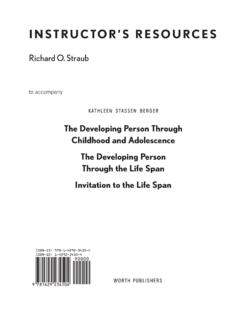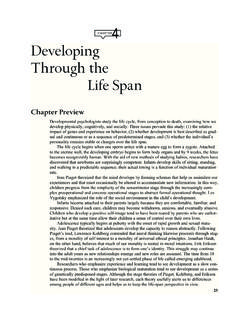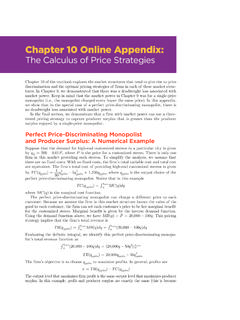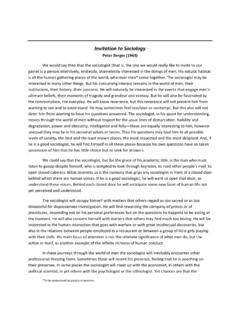Transcription of Emerging Adulthood: Biosocial Development
1 Chapter PreviewIn terms of overall health, the years of Emerging adulthood are the prime of life. Althoughthe efficiency of most body systems begins to decline in the 20s, most changes go unnoticedbecause of organ and muscle reserve. However, with the attainment of full maturity, a newaspect of physical Development comes into play that is, decline. Chapter 17 takes a lookat how the decisions young adults make regarding lifestyle affect the course of their over-all chapter begins with a description of the growth, strength, and health of the indi-vidual during Emerging adulthood , including declines in the efficiency of the body s sys-tems. Sexual-reproductive health, a matter of great concern to young adults, is also dis-cussed.
2 Although physical well-being increases during Emerging adulthood , so does the rate ofpsychological disorders. The stresses of this period of life combine with genetic vulnerabili-ty in some individuals to trigger substance abuse and the Development of mood disorders,anxiety disorders, or schizophrenia. The final section of the chapter addresses the importance of good health habits,including regular exercise, good nourishment, and avoiding risky behaviors. The sectionconcludes with a discussion of how social norms can reduce risk taking and improve healthhabits in this age group. What Have You Learned?The What Have You Learned? questions at the end of the text chapter are reprinted herefor your convenience in checking students' understanding of the chapter Why is maximum physical strength usually attained in Emerging adulthood ?
3 2. How is homeostasis apparent in the human need for nutrition?3. How does organ reserve protect against heart attacks? 4. What advantages do Emerging adults have in their physical appearance? 5. Why do most 20-year-olds not want to get married? 6. Biologically, what is the best age to have a baby?7. Why are STIs more common currently than 50 years ago? 8. What is the usual pattern of well-being during Emerging adulthood ?9. Why do depressed people tend not to seek help?10. What anxiety disorders are more likely in your culture?11. What evidence suggests that schizophrenia is not totally genetic?12. Why is the nutrition of Emerging adults often better than that of other adults?13. How does exercise in early adulthood affect health in late adulthood ?
4 8517 CHAPTERE merging adulthood : Biosocial Development14. What are the social benefits of risk taking? 15. How do vocational choices change between early and later adulthood ?16. Why are some sports more attractive at some ages than others?17. Why are serious accidents more common in Emerging adulthood than later?18. How can committing a crime be considered an example of edgework?19. Why are college students more likely to abuse drugs than those not in college?20. What is the difference between drug abuse and addiction? 21. Why are social norms particularly powerful in Emerging adulthood ?Chapter Guide On Your Own Activities: Developmental Fact or Myth?; Portfolio Assignment AV: The Journey Through the Life Span, Program 7: Early adulthood ; Transitions Throughoutthe Life Span, Program 17: Early adulthood : Biosocial DevelopmentI.
5 Growth and StrengthInstructional Objective: To describe the normal physiological changes in growth,strength, and health, and age-related changes in the sexual-reproductive system that occurduring Emerging adulthood . AV: Factors in Healthy Aging; Brain Architecture and the Sexes Classroom Activity: Over the Hill : Introducing the Topic of Senescence On Your Own Activity: Test Your Face for Symmetry, Observational Activity: Physical Stereotyping in the Media1. The years from 18 to 25 ( Emerging adulthood ) can be considered the prime of life interms of physiological Development . Whatever difficulties young adults experience inbiosocial Development are usually not related to Full height is usually reached at about age 16 in females and 18 in Muscle growth and fat accumulation continue into the early 20s.
6 4. In both sexes, physical strength increases during the 20s, then gradually Digestive, respiratory, circulatory, and sexual-reproductive systems function at anoptimum level during early Most visits to the doctor are necessitated not by disease but by injuries or Diagnostic tests such as mammograms, PSA testing, and colonoscopies are not rou-tinely recommended until age , or age-related physical decline, begins in late the adjustment of the body s systems to keep the physiological func-tions in a state of equilibrium. Many homeostatic resources are regulated in the brainby the pituitary. It is most efficient during Emerging adulthood . 10. Anther reason young adults are rarely seriously ill is the organ reserve,the extracapacity that each organ has for responding to unusually stressful events or prolongedeffort.
7 The body also has a muscle reserve, but muscle capacity typically begins todecline by age 25, though change is so gradual that the functioning required for dailylife is largely unaffected until late Although the average maximumheart rate declines steadily with age, the restingheart rate remains Most Emerging adults look vital and attractive. They care about their looks for tworeasons: sexual attraction and better jobs with higher pay. 13. The sexual-reproductive system is at its strongest during Emerging adulthood . Youngadults are more fertile, have more frequent orgasms, have fewer miscarriages, andrarely encounter serious birth complications. Testosterone levels are high in both menand women.
8 86 Chapter 17 Emerging adulthood : Biosocial Development14. Attitudes toward sex have changed over the past 50 years. For example, most emerg-ing adults today condone premarital sex. Still, most sexually active adults have onesteady partner at a time, a pattern of sexual activity called serial (Thinking Critically) Some developmentalists refer to the cohort of Emerging adultswho became young adults in the year following 2000 as Millennials, or GenerationNext. In the United States, some scholars also call this cohort Generation Me becausethey are more selfish, egotistical, and narcissistic than previous Half the people in the United States believe that the primary purpose of sex is tostrengthen relationships.
9 This attitude is especially common among women. Aboutone-fourth of all people in the United States believe that the primary purpose of sex isreproduction. This attitude is more common among women and older adults. Theremainder believe that the primary purpose of sex is recreation. This attitude is morecommon among One consequence of sexual patterns among today s young adults is that the incidenceof sexually transmitted infections (STIs) is higher today than ever before. The bestway to prevent STIs is through lifelong PsychopathologyInstructional Objective: To discuss the possible Development of psychopathology duringemerging adulthood . Audiovisual Materials: Depression Disorders; Exploring Psychological Disorders (CD-ROM);Postpartum Depression and the Yates Killing; No More Shame: Understanding Schizophrenia,Depression, and Addiction Classroom Activities: Student-Generated Case Studies; What Would Dr.
10 Phil Say? On Your Own Activiy: Zung Self-Rating Depression Scale Critical Thinking Activity: Gender Differences in Depression1. Unlike physical health, which peaks during the years of Emerging adulthood , psycho-logical health does not peak for all adults at this age. Except for dementia, emergingadults experience more of every diagnosed disorder than any older According to the diathesis-stress model, disorders such as schizophrenia are pro-duced by the interaction of stressful environmental factors and life events with anunderlying genetic vulnerability (the diathesis).3. Before age 30, approximately 8 percent of residents suffer from a mood disorder:mania, bipolar disorder, or severe depression.

















